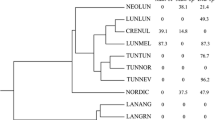Abstract
Coreopsis mutica is a highly variable species occurring in the highlands from Central Mexico southeastward barely into El Salvador and Honduras. It is not continuous over this range, however, but is found in three geographic population centers: one in Guatemala and Chiapas, a second in Oaxaca, and the third in Central Mexico. Populations in Guatemala and Chiapas are uniform in chromosome number (2n = 56), leaf flavonoid chemistry, and morphology. Var.microcephala is proposed to accommodate these assemblages. Plants comprising populations centered around Cd. Oaxaca have a chromosome number of 2n = ca. 112. This large complex consists of two distinct varieties and their putative hybrids. Those plants to the northwest of Cd. Oaxaca (var.subvillosa) are constant in leaf flavonoid chemistry (producing only flavones) and possess a combination of distinctive morphological traits. To the southeast of Cd. Oaxaca plants invariably contain flavonols and anthochlors in their leaves in addition to flavones. Moreover, these plants (the newly proposed var.carnosijolia) are readily separable from var.subvillosa by a number of morphological features. Evidence is presented that the two taxa hybridize in the vicinity of Cd. Oaxaca. On the southeastern edge of the var.subvittosavar. carnosifolia complex a population was encountered which has a chromosome number of 2n = 56 and a very distinctive morphology and flavonoid chemistry. These plants have been accorded taxonomic status as var.multiligulata. Two morphologically similar, yet distinguishable, varieties occur in Central Mexico. It has been determined that the two differ also in chromosome number and leaf flavonoid chemistry. One taxon (var.leptomera) has a chromosome complement of 2n = 56 and produces only flavones in its leaves, whereas var.mutica has a chromosome number of 2n = ca. 112 and produces flavones, flavonols, and anthochlors.
Similar content being viewed by others
Literature Cited
Crawford, D. J. 1970.In: IOPB chromosome number reports XXV Taxon19: 102.
Geissman, T, A., J. B. Harborne, &Margaret K. Seikel 1956. Anthochlor pigments. XI. The constituents ofCoreopsis maritima. Reinvestigation ofCoreopsis gigantea. Jour. Amer. Chem. Soc.78: 825–829.
Harborne, J. B. 1964. Plant polyphenols-XI. The structure of acylated anthocyanins. Phytochemistry3: 151–160.
— 1967a. Comparative biochemistry of the flavonoids-VI. Flavonoid patterns in the Bignoniaceae and the Gesneriaceae. Phytochemistry6: 1643–1651.
— 1967b. Comparative Biochemistry of the Flavonoids. London & New York: Academic Press, viii + 383 pp.
Jurd, L. 1962. Spectral properties of flavonoid compounds, pp. 107–155.In: T. A. Geissman (Editor). The Chemistry of the Flavonoid Compounds. New York: Macmillan Company. viii + 666 pp.
Levin, D. A. 1968. The genome constitutions of eastern North AmericanPhlox amphiploids. Evolution22: 612–632.
Markham, K. R. &T. J. Mabry 1968a. The identification of twenty-three 5-deoxy- and ten 5-hydroxy-fIavonoids fromBaptisia lecontei (Leguminosae). Phytochemistry7: 791–801.
— 1968b. A procedure for the ultraviolet spectral detection of ortho-dihydroxyl groups in flavonoids. Phytochemistry7: 1197–1200.
McClure, J. W. &R. E. Alston 1966. A chemotaxonomic study of Lemnaceae. Amer. Jour. Bot.53: 849–860.
Sherff, E. E. 1936. Revision of the genusCoreopsis. Field Museum Nat. Hist. Bot. Ser.11(6): 277–475. (Publ. 366.)
-. 1955.Coreopsis, pp. 4–40.In: E. E. Sherff & E. J. Alexander. Compositae—Heliantheae -Coreopsidinae. North Amer. Flora II. Pt. 2.
Smith, D. M. &D. A. Levin 1963. A Chromatographic study of reticulate evolution in the AppalachianAsplenium complex. Amer. Jour. Bot.50: 952–958.
Turner, B. L., M. Powell, &R. M. King 1962. Chromosome numbers in Compositae. VI. Additional Mexican and Guatemalan species. Rhodora64: 251–271.
Author information
Authors and Affiliations
Rights and permissions
About this article
Cite this article
Crawford, D.J. Systematic studies on mexican coreopsis (compositae). Coreopsis mutica: Flavonoid chemistry, chromosome numbers, morphology, and hybridization. Brittonia 22, 93–111 (1970). https://doi.org/10.2307/2805804
Issue Date:
DOI: https://doi.org/10.2307/2805804




